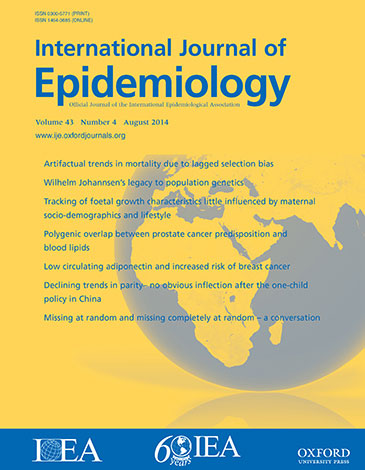COVID-19疫苗接种后急性后非特异性症状:一项基于丹麦人群的研究
IF 5.9
2区 医学
Q1 PUBLIC, ENVIRONMENTAL & OCCUPATIONAL HEALTH
引用次数: 0
摘要
背景:在COVID-19疫苗接种后经常报告急性后非特异性症状,如头痛、肌肉疼痛和疲劳,这引起了对不良事件的关注。由于疫苗犹豫的个体可能更容易出现疫苗症状,本研究调查了COVID-19疫苗接种是否会增加急性后非特异性症状的几率,并按COVID-19疫苗犹豫分层。方法:这项纵向研究使用了来自BiCoVac队列的重复测量数据,该队列随机抽样了913116名年龄在16-65岁之间的丹麦公民。通过国家登记和问卷调查(2021年5月至2022年6月)收集数据。使用25项身体痛苦综合征检查表确定非特异性症状,并通过比较接种疫苗和未接种疫苗的个体使用logistic和线性回归模型进行分析。模型具有鲁棒标准误差和逆概率选择权值。结果共收集61 316例未关注COVID-19疫苗个体的观察结果132 776条,25 272例怀疑COVID-19疫苗个体的观察结果52 325条,5064例关注COVID-19疫苗个体的观察结果10 242条。在未接种疫苗的个体中,与未接种疫苗的个体相比,接种疫苗的个体出现大多数症状的几率较低。接种疫苗后4周[例如肌肉疼痛:优势比(OR) = 0.56, 95%可信区间(CI): 0.47-0.68]。在对疫苗持怀疑态度的个体中也发现了类似的趋势,尽管估计值有所降低。相反,在接种疫苗的个体中,我们观察到大多数症状的发生率较高的趋势。接种疫苗后4周与未接种疫苗的个体相比(例如肌肉疼痛:OR = 1.23, 95% CI: 0.91-1.67)。结论对于大多数16-65岁的个体,我们没有发现COVID-19疫苗接种后急性后症状的证据。然而,接种过疫苗的人更有可能报告大多数症状,这可能是由于报告偏倚或反安慰剂效应。本文章由计算机程序翻译,如有差异,请以英文原文为准。
Post-acute non-specific symptoms following COVID-19 vaccination: a Danish population-based study
Background Post-acute non-specific symptoms such as headaches, muscular pain, and fatigue are frequently reported following COVID-19 vaccination, raising concerns about adverse events. As vaccine-hesitant individuals may be more likely to experience symptoms of vaccines, this study investigates whether COVID-19 vaccination increases the odds of post-acute non-specific symptoms, stratified by COVID-19 vaccine hesitancy. Methods This longitudinal study uses repeated measurements from the BiCoVac cohort—a random sample of 913 116 Danish citizens aged 16–65 years. Data were collected through national registers and questionnaires (May 2021–June 2022). Non-specific symptoms were identified by using the 25-item Bodily Distress Syndrome checklist and analysed by using logistic and linear regression models comparing vaccinated and unvaccinated individuals. Models were fitted with robust standard errors and inverse probability of selection weights. Results A total of 132 776 observations were collected from 61 316 COVID-19 vaccine-unconcerned individuals, 52 325 observations from 25 272 COVID-19 vaccine-sceptical individuals, and 10 242 observations from 5064 COVID-19 vaccine-concerned individuals. Among the vaccine-unconcerned individuals, those vaccinated had lower odds of most symptoms compared with unvaccinated individuals >4 weeks post-vaccination [e.g. muscular pain: odds ratio (OR) = 0.56, 95% confidence interval (CI): 0.47–0.68]. A similar tendency was found for vaccine-sceptical individuals, although with attenuated estimates. Conversely, among vaccine-concerned individuals, we observed a tendency for higher odds of most symptoms >4 weeks post-vaccination compared with unvaccinated individuals (e.g. muscular pain: OR = 1.23, 95% CI: 0.91–1.67). Conclusion For most individuals aged 16–65 years, we found no evidence of post-acute symptoms after COVID-19 vaccination. Vaccinated vaccine-concerned individuals were, however, more likely to report most symptoms, potentially due to reporting bias or nocebo effects.
求助全文
通过发布文献求助,成功后即可免费获取论文全文。
去求助
来源期刊

International journal of epidemiology
医学-公共卫生、环境卫生与职业卫生
CiteScore
13.60
自引率
2.60%
发文量
226
审稿时长
3 months
期刊介绍:
The International Journal of Epidemiology is a vital resource for individuals seeking to stay updated on the latest advancements and emerging trends in the field of epidemiology worldwide.
The journal fosters communication among researchers, educators, and practitioners involved in the study, teaching, and application of epidemiology pertaining to both communicable and non-communicable diseases. It also includes research on health services and medical care.
Furthermore, the journal presents new methodologies in epidemiology and statistics, catering to professionals working in social and preventive medicine. Published six times a year, the International Journal of Epidemiology provides a comprehensive platform for the analysis of data.
Overall, this journal is an indispensable tool for staying informed and connected within the dynamic realm of epidemiology.
 求助内容:
求助内容: 应助结果提醒方式:
应助结果提醒方式:


